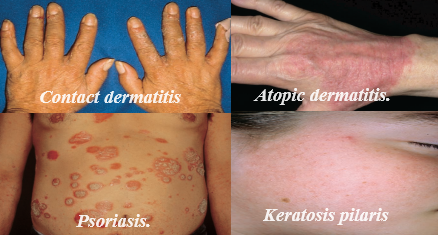Common Reactions, Rashes, And Irritations

Sensitive Skin, Allergies, and Irritants, we discuss common allergies that the aesthetician sees routinely.
Dermatitis means inflammation of the skin.
It is a descriptive term used to describe many different types of skin inflammation and irritation.
Dermatitis is an irritation rather than a disease.
It is generally not caused by pathological organisms, such as infections caused by viruses, bacteria, and fungi.
Contact Dermatitis
Contact dermatitis is probably the most common form of dermatitis observed by the aesthetician.
Contact dermatitis is an irritation caused by an allergic reaction or irritation to something or by some substance touching the skin or coming in contact with the skin’s surface.
Cosmetics are a frequent cause of contact dermatitis.
Other frequent causes of contact dermatitis include jewellery, laundry products, clothing fabrics, and dyes, plants (such as poison ivy), and other substances.
There are two basic treatments for contact dermatitis.
The first, of course, is to avoid contact with the offending substance.
This is sometimes hard to pinpoint because we touch so many substances on a daily basis.
Often the dermatologist can tell much about the source of irritation by the location of the dermatitis.
Irritation of the hands is often caused by household products.
Health and personal care professionals, including aestheticians, often suffer from dermatitis related to substances they touch at work.
Irritation from hand washes, disinfectants, and antiseptics even allergies to latex gloves are frequently seen in these professionals.
Aestheticians also come in contact with a large number of cosmetic products, which can also be a source of irritation.
The process of eliminating the offending substance is often a matter of trial and error: eliminating one or all substances and testing by slowly adding steps of substance contact.
Allergies are sometimes easier to detect.
The dermatologist often runs allergy patch tests, and allergies have a tendency to be more acute than irritation dermatitis.
The second part of contact dermatitis treatment is to soothe and stop the inflammation.
Topical steroid creams are often prescribed by the dermatologist to ease the symptoms of allergic or irritant dermatitis.
These prescription creams usually work fairly quickly, assuming that the source of irritation has also been eliminated.
Dermatitis can have many characteristics visually, but it is usually red (erythemic) and often itchy or burning.
The term eczema is often used interchangeably with the term dermatitis.
Atopic Dermatitis
Atopic eczema or dermatitis is a more complicated form of dermatitis.
It is a more severe and chronic condition and is associated, in most cases, with heredity.
It may be affected by illness, stress, and other changes.
Some patients suffer from atopic dermatitis all their lives.
It can occur anywhere on the body, but it is very common on the extremities, including hands and arms, and legs and feet.
Atopic eczema can be controlled with the use of prescription steroid creams and oral antihistamines.
Cosmetologically, the patient with atopic eczema is more likely to have irritant reactions to cosmetics.
If you have a client with atopic eczema, discuss any cosmetics with the client’s doctor.
In general, stick to fragrance-free, simple products the simpler the better, and the fewer ingredients the better.
It is very important for patients with atopic dermatitis to maintain proper barrier function.
Impaired barrier function can start a flare of eczema in chronic eczema patients.
Clients should maintain daily moisturization of the skin to help avoid flares.
Occasionally, you may notice a rash following a pattern on the face that does not clear up.
Rashes in a butterfly pattern across the cheeks can be a symptom of lupus erythematosus.
If you notice a recurrent rash on a client’s face, you should refer the client to a physician, as you should with all rashes and chronic redness.
Seborrheic Dermatitis
Seborrheic dermatitis is a commonly seen and often chronically reoccurring condition that appears as red, flaking, dry-looking skin in the hairline, eyebrows, T-zone, corners, and sides of the nose, and the ears.
Inexperienced aestheticians and clients often view this condition as “dry skin” and treat it with moisturizers; this method is not only ineffective but may actually worsen the condition.
Occasionally rich moisturizers can trigger a flare.
Seborrheic dermatitis is actually an inflammation of the sebaceous glands, and it is more common in men.
It may flare with changes in weather or season, or when the patient is experiencing unusual amounts of stress.
Seborrheic dermatitis is treated with steroid creams and prescription anti-fungal creams.
Although the cause is not completely understood, it is thought to be associated with the presence of a skin yeast called pityrosporum ovale.
Psoriasis
Psoriasis is an autoimmune inflammatory disease of the skin that is caused by the skin and epidermis “turning over” faster than it does in a normal individual.
It is believed to be genetic and can be chronic and last over a lifetime.
Psoriasis is not contagious and is not related to any pathological organism.
Psoriasis primarily affects the skin on the body and is often symmetrical, which means it occurs simultaneously on both sides of the body in the same place.
It often affects the elbows, the knees, and other extremities.
Treatments used to control psoriasis include steroid creams, antihistamines, and light therapy using controlled exposures of ultraviolet A (UVA).
Promising treatment is now also available using a class of drugs called biologics, which are protein compounds prepared from live cells.
These drugs help suppress different biochemical reactions that cause psoriasis, helping to control and prevent symptoms.
Urticaria
An outbreak of urticaria, or hives, is due to allergies.
Urticaria often quickly fades without treatment, but the source of the allergy should be identified.
Dermatologists use topical steroids, oral steroids, antihistamines, and allergy testing to treat and identify causes of urticaria.
Keratosis Pilaris
Keratosis pilaris is a chronic condition in which the skin exhibits redness and irritation in patches, accompanied by a rough texture and small pinpoint-sized white papules that look like very small milia.
Keratosis pilaris is often found on the cheeks and upper arms.
It is often seen in children and teenagers, but it can affect any age group.
Many children outgrow the condition.
In most cases, it is a nuisance disorder.
Mild forms of keratosis pilaris can be successfully treated and controlled with mild glycolic or lactic acid moisturizers used on a daily basis, along with gentle periodic exfoliation with mild scrubs or gommages.
Severe forms should be referred to a dermatologist.








